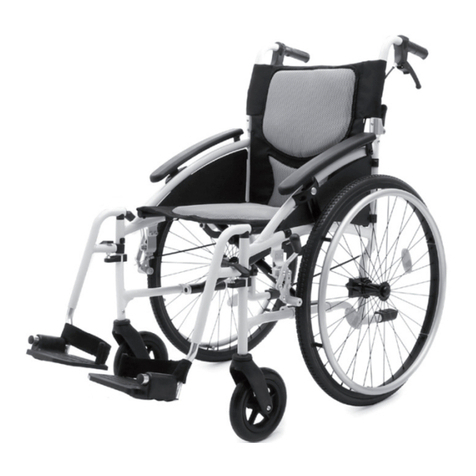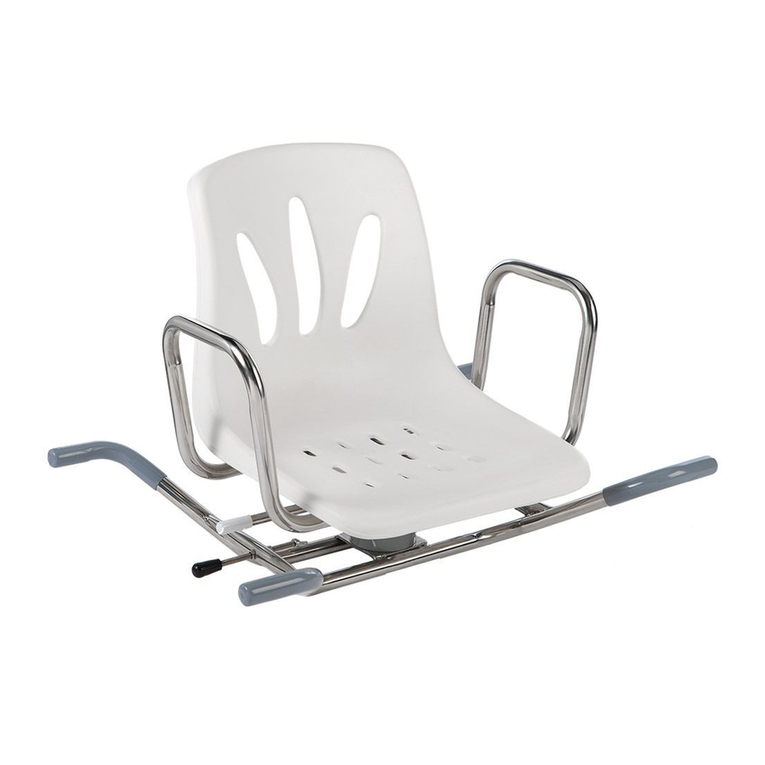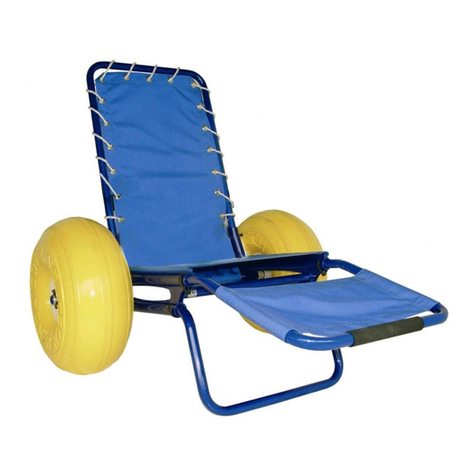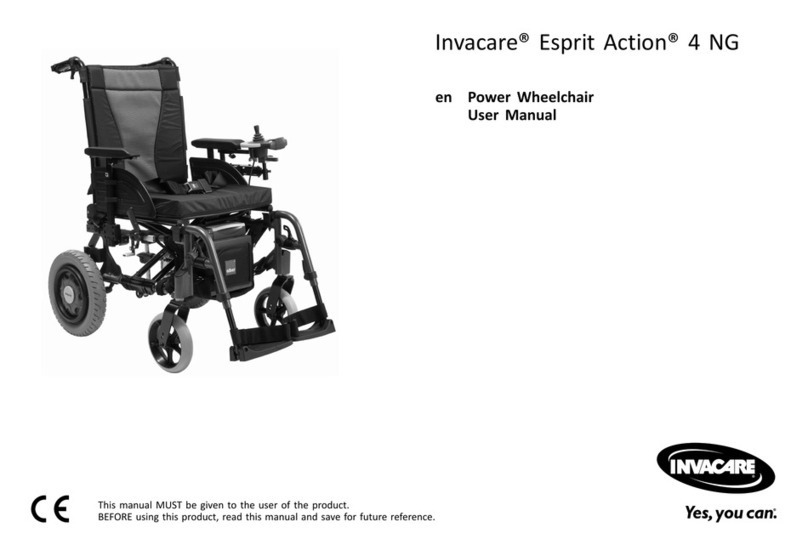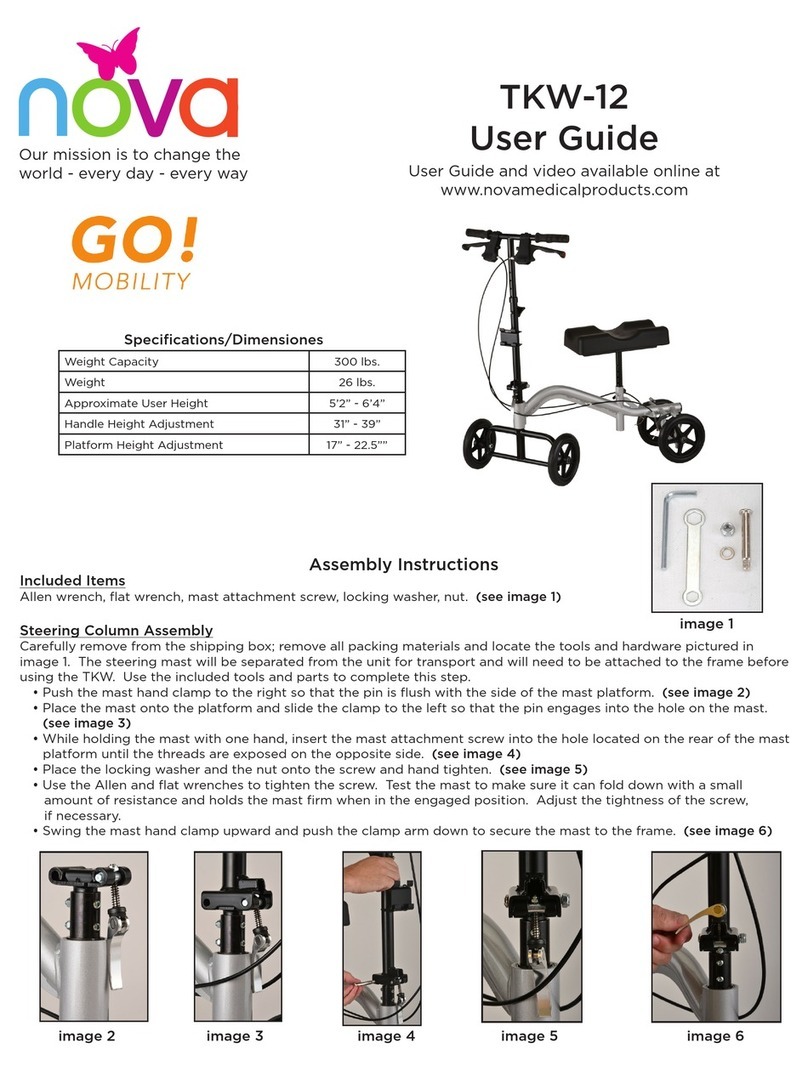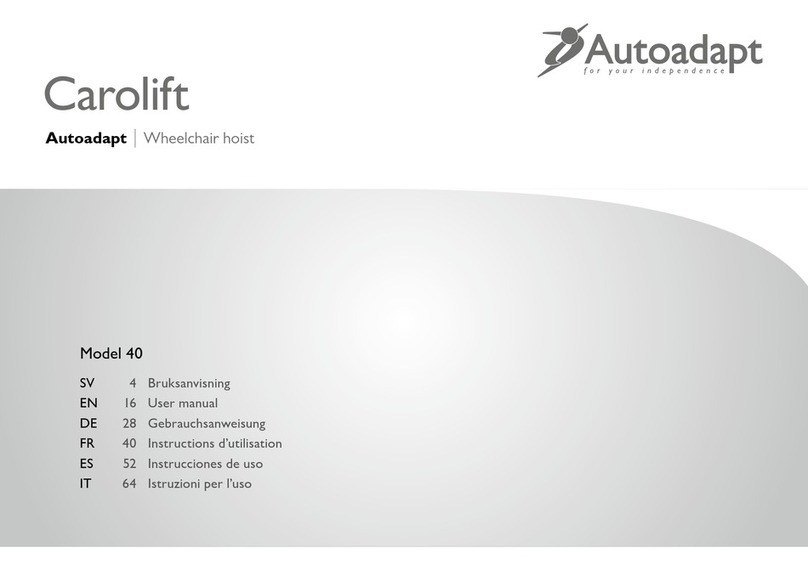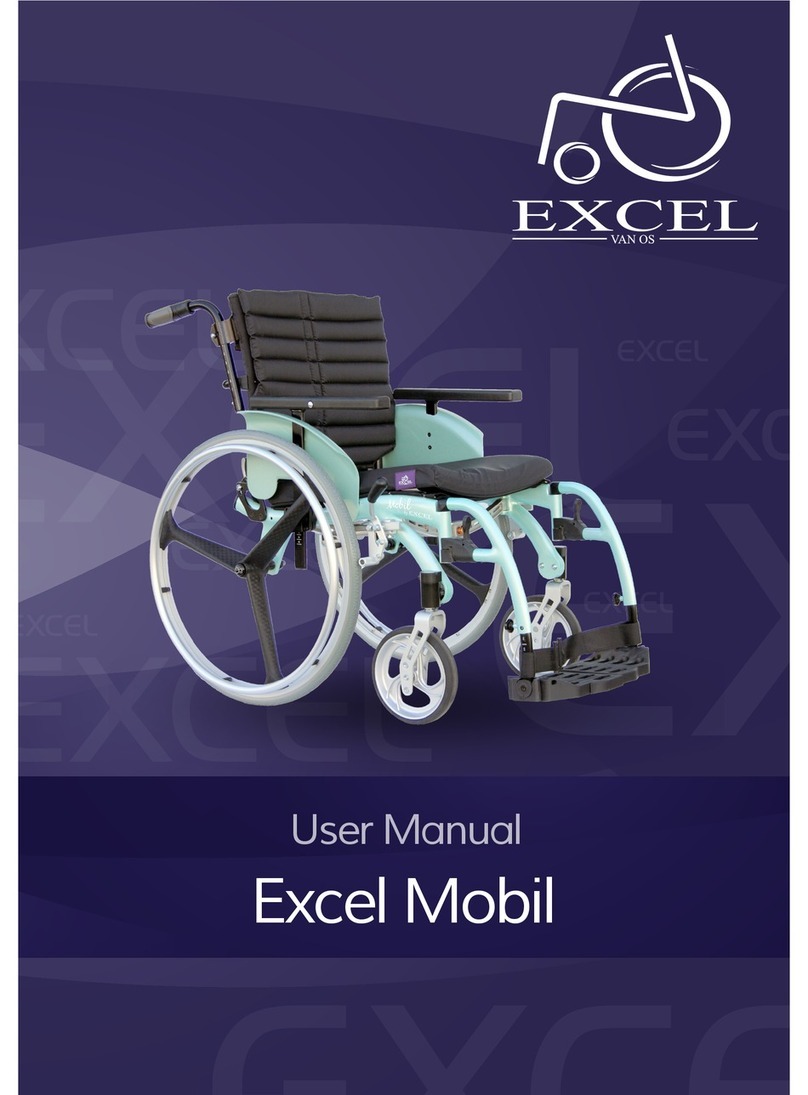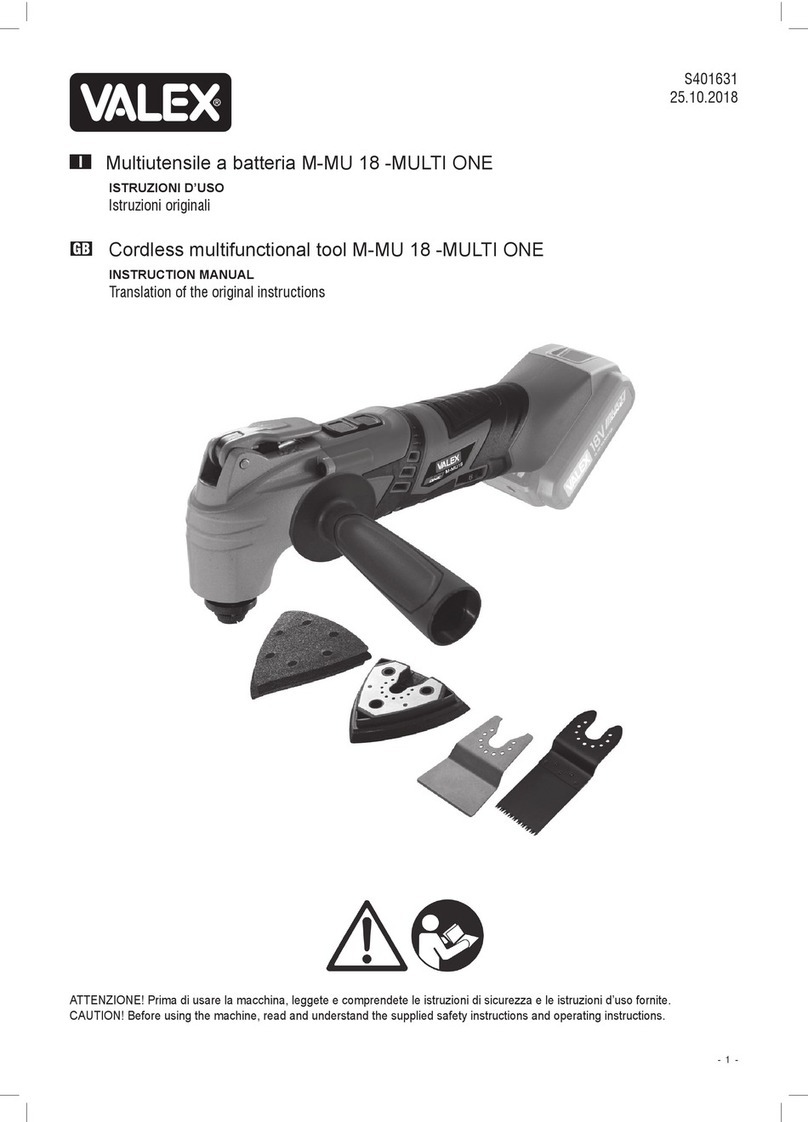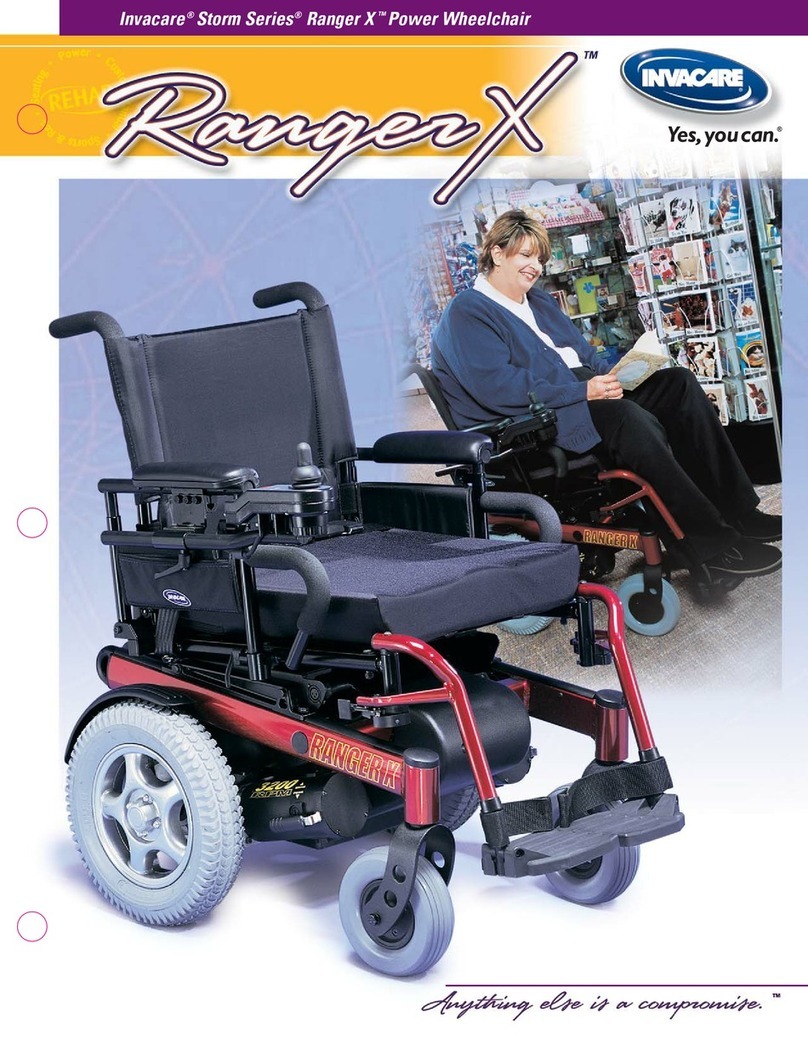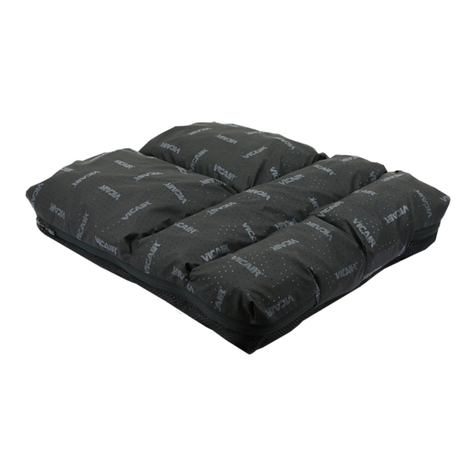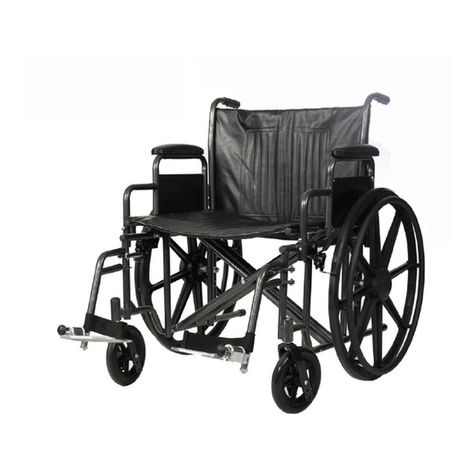Orliman actius ACWC01#40 Assembly instructions

ACWC01#40/43/46/49
ACWC04#40/43/46/49
ACWC02#40/43/46/49
ACWC03#40/43/46/49
by
ES EN
INSTRUCCIONES DE
USO Y CONSERVACIÓN
INSTRUCTIONS FOR USE AND CARE
WHEELCHAIR
SILLAS DE RUEDAS


INSTRUCCIONES DE USO Y CONSERVACIÓN
1. NORMATIVA
2. INDICACIONES
3. IDENTIFICACIÓN DEL PRODUCTO
4. INSTRUCCIONES DE SEGURIDAD
4.1. Normas generales de seguridad
4.2. Advertencias y precauciones para un uso seguro
5. INSTRUCCIONES DE USO
5.1. Consejos de seguridad
5.2. Uso en superficies desiguales
5.3. Subida y bajada de rampas
5.4. Subir y bajar las escaleras
6. COMPONENTES DE LAS SILLAS DE RUEDAS
6.1. Componentes de la silla de ruedas.
7. INSTRUCCIONES PARA EL CORRECTO USO
8. TRANSPORTE Y TRASLADO EN EL COCHE
8.1. Cómo desmontar la silla de ruedas
8.2. Cómo montar la silla de ruedas
9. DATOS TÉCNICOS
10. MANTENIMIENTO
10.1. Garantía
10.2. Ruedas
10.3. Frenos
10.4. Marcos transversales
10.5. Ruedas traseras
10.6. Ruedas delanteras y horquillas de las ruedas delanteras
10.7. Tapizado
10.8. Limpieza
ES

Estimado cliente,
Muchas gracias por su confianza en un producto de Actius
by Orliman. Usted adquirió un producto de calidad. Por favor,
lea las instrucciones atentamente antes de la utilización del
producto, y utilice el producto únicamente tal y como se des-
cribe, y para los fines previstos.
Si tienen alguna duda sobre el uso, mantenimiento o segu-
ridad de su producto, póngase en contacto con el estableci-
miento sanitario donde adquirió el producto o con nuestro
departamento de atención al cliente.
1. NORMATIVA
Este producto es conforme a la Directiva Europea de Produc-
tos Sanitarios 93/42/CEE (RD. 1591/2009). Se ha realizado
un Análisis de Riesgos (EN ISO 14971) minimizando todos los
riesgos existentes.
Para el desecho del envase y del producto, cumpla estricta-
mente con las normas legales de su comunidad.
2. INDICACIONES
Incrementar la movilidad mediante desplazamiento autopro-
pulsado o con asistente para personas que no pueden ca-
minar o con movilidad reducida, tanto en interiores como en
exteriores siempre que el terreno sea firme, nivelado y seco.
El usuario no debe superar el peso máximo indicado.
3. IDENTIFICACIÓN DEL PRODUCTO
Está equipada con un número de serie único, que se encuen-
tra en el bastidor. Encontrará la explicación de los distintos
tipos de información incluida en la etiqueta, tal y como se
presenta a continuación.
1. Nombre del modelo: el nombre del modelo de su silla de
ruedas.
2. Número de serie: cada silla de ruedas tiene su número de
serie único. Cuando desee realizar una solicitud técnica o
al tratarse de piezas en garantía, se requerirá el número
de serie.
3. Peso máximo del usuario: el peso máximo permitido que
el usuario puede tener para la seguridad del usuario y de
la silla de ruedas.
4. Fecha de fabricación: fecha de fabricación de su silla de
ruedas.
5. Número del modelo: este número indica qué modelo de
silla de ruedas tiene, y también se requiere indicarlo en el
caso de hacer una solicitud técnica.
4. INSTRUCCIONES DE SEGURIDAD
ORLIMAN no se hace responsable en ningún caso de cual-
quier lesión corporal o daños materiales que puedan ocurrir
durante cualquier tipo de uso que no cumpla con las leyes y
ordenanzas. Si se utiliza correctamente, es un producto que
proporciona máxima seguridad y estabilidad, siempre que se
sigan las instrucciones descritas en este manual. No obstan-
te, en caso de uso incorrecto de la silla de ruedas, es posible
que se produzcan situaciones peligrosas.
4.1. Normas generales de seguridad
Proteja su silla de ruedas, comprobándola periódicamente.
Cuando una pieza de su silla de ruedas no funciona adecua-
damente, puede dar lugar a una situación peligrosa.
� Advertencia: tiene que mantener su silla de ruedas en
buen estado para garantizar un uso seguro.
4.2. Advertencias y precauciones para un
uso seguro
� Advertencias:
• Por favor, antes de usar el producto, lea detenidamente
las instrucciones de uso. Debe familiarizarse con el ma-
nejo, funciones y utilización del mismo antes de su uso.
Puede comprometer su seguridad si no presta atenció-
na estas instrucciones. Tenga en cuenta además que
esimposible una protección total así como el evitar cir-
cunstancias y situaciones imprevistas.
• No suba o baje escaleras sin la ayuda de un asistente.
Deberá utilizar rampas o elevadores si están disponi-
bles. Si no hay infraestructuras disponibles para sillas-
de ruedas, la silla debe ser manipulada por dos perso-
nas para salvar el obstáculo.
• Existe riesgo de accidente cuando se maneje la silla
sin experiencia. Pueden producirse caídas y otras si-
tuaciones peligrosas. Por lo tanto, familiarícese con la
nueva silla de ruedas practicando en un terreno firme
y liso. Aprenda cómo se comporta la silla con el cambio
del centro de gravedad, por ejemplo en rampas o suelo
inclinado, o cuando esquive obstáculos como escalo-
nes o curvas. Esto debe realizarse con la ayuda de otra
persona.
• Si no se cumplen las instrucciones descritas en este
manual, la silla de ruedas se puede dañar o pueden
producirse lesiones a nivel de usuario.
• Evite utilizar la silla de ruedas en carreteras. Utilice las
aceras, si es posible.
• No utilice la silla de ruedas en arena, superficies irre-
gulares, mojadas, resbaladizas o con poca adherencia.
• No utilice la silla de ruedas si está rota o no funciona
adecuadamente.
• Estas sillas estándar no están aprobadas para el trans-
porte en un vehículo adaptado a minusválido. Los usua-
rios de sillas de ruedas deben siempre ser transferidos
a los asientos adaptados en el vehículo. Si no se respe-
tan estas instrucciones la silla de ruedas podría fallar
en caso de accidente y pueden provocarse daños en el
usuario así como a cualquier otro pasajero del vehículo.
• No se recline hacia atrás con la silla de ruedas. Esta
acción podría volcar la silla de ruedas.
• Antes de inclinarse hacia delante o disponerse a avan-
zar, posiciónese hacia la parte trasera del asiento y si-
túe las ruedas hacia delante, paralelamente.
• No conduzca por los bordillos
• Antes de inclinarse hacia delante, posiciónese hacia el
respaldo y asegúrese que las ruedas delanteras están
orientadas hacia delante.
• No conecte nunca, nada, a las ruedas. Esto podría oca-
sionar daños a la silla de ruedas y tener efecto negativo
en el equilibrio de la silla de ruedas, además de poder
ocasionar daños al usuario.
• Aplique los frenos cuando quiera levantarse o le es-
tánlevantando. Los frenos sobre las ruedas no actúan
como un freno a la marcha sino que están diseñados
como un bloqueo de la rueda cuando la silla está de-
tenida. Los frenos de las ruedas no deben ser usados
como frenos de conducción para aminorar la marcha,
ya que en casos extremos, un bloqueo brusco de la rue-

da puede dar lugar a caídas.
• La máxima capacidad de peso está indicada en la eti-
queta del bastidor y en el apartado DATOS TECNICOS.
El peso máximo usuario incluye el peso del usuario más
el peso de los accesorios instalados en la silla de rue-
das y de cualquier otro elemento incorporado (bolsa de
la compra, equipo de oxígeno portátil, etc.).
• Para una protección adecuada en caso de obstrucción
potencial, los reposapiés deberían encontrarse a un mí-
nimo de 7 cm del suelo.
• No se levante encima del reposapiés, esto podría cau-
sar que su silla de ruedas vuelque, dañando a su usua-
rio. (Figura 1)
• Sitúe la silla de ruedas en una superficie estable, pla-
na, y active los frenos antes de pasar a o de la silla de
ruedas a otra zona.
• Las modificaciones no autorizadas y/o el uso de piezas
que no han sido suministradas por ORLIMAN, llevará
a la invalidación de la garantía de la silla de ruedas y
podría producir una lesión al usuario y/o daños a la silla
de ruedas.
5. INSTRUCCIONES DE USO
Deberá aprender las características de su silla de ruedas.
Es de suma importancia aprender las medidas de seguridad
para desarrollar actividades diarias de acuerdo con su estilo
de vida. Consulte con su médico o su terapeuta para asisten-
cia en aprender las técnicas más eficaces para sus activida-
des diarias, de acuerdo con sus posibilidades físicas.
5.1. Consejos de seguridad
Operaciones diarias, como bajarse de la silla de ruedas,
agacharse o intentar alcanzar algo desde la silla de ruedas
causará un cambio en la distribución del peso, y en el cen-
tro de gravedad entre usted y la silla de ruedas. Tendrá que
efectuar esos movimientos y técnicas como las descritas a
continuación.
⇢ El traslado:
El traslado en una silla de ruedas es una maniobra difícil.
Consulte con su fisioterapeuta para asistencia en desarrollar
su técnica individual. Las posibilidades que tiene de efectuar
un traslado dependen de sus características físicas. Por ello,
le aconsejamos que primero se ponga en contacto con su
fisioterapeuta.
No obstante, si tiene bastante fuerza corporal y quiere tras-
ladarse a/desde la silla de ruedas, la mejor manera de hacer-
lo es la siguiente:
⇢ Para bajar de la silla de ruedas:
Primero de todo, se tiene que asegurar que su silla de rue-
das está ubicada lo más cerca posible del sitio al que quiere
pasar. Coloque las ruedas hacia delante y active los frenos.
Abata los reposapiés y coloque los pies en el suelo. Ahora
está en la posición correcta para llevar a cabo la operación.
Transfiera su peso hacia la parte delantera de la silla, para
ello puede utilizar los reposabrazos como soporte y empiece
a moverse hacia el sitio donde quiere trasladarse. Si fuera
necesario, podría utilizar una placa de traslado.
⇢ Para entrar:
Para poder sentarse en su silla de ruedas, tendrá que realizar
los mismos pasos que cuando quería bajar de la silla de rue-
das, pero en orden inverso.
⇢ Alcanzar la silla de ruedas:
Le recomendamos encarecidamente que le pida ayuda a su
asistente o ciudador en caso de querer recoger algo del suelo.
5.2. Uso en superficies desiguales
⇢ Subir a la acera:
Su cuidador o asistente le puede ayudar en la subida de dos
maneras distintas, sin embargo, nosotros le recomendamos
que siga la primera opción.
1. En el primer método para subir a superficies desiguales,
usted y su ayudante tienen que alcanzar la acera de orien-
tados hacia delante. El ayudante tiene que empujar las
empuñaduras hacia él y colocar su pie en la barra de in-
clinación/stepper (véase la figura 2). Cuando el ayudante
esté llevando a cabo simultáneamente las dos operacio-
nes, se producirá un efecto palanca que va a inclinar la
silla de ruedas, tal y como se indica en la figura 2.
2. En el segundo método, el ayudante ya está subido a la
acera y se asegura de que la silla de ruedas está posicio-
nada con las ruedas traseras lo más cerca posible del bor-
dillo. El usuario de la silla de ruedas se tiene que inclinar
hacia atrás. De este modo, la silla de ruedas se inclinará
hacia atrás y el cuidador podrá subir la silla a la acera. El
ayudante se tiene que asegurar de que las ruedas delan-
teras están en la acera antes de soltar la silla de ruedas.
� Advertencia:
No lleve la silla de ruedas por los bordillos.
⇢ Bajar de la acera:
El ayudante tiene que posicionar la silla de ruedas orientada
hacia la acera. Después, el usuario tiene que inclinarse hacia
atrás de manera que el ayudante pueda inclinar la silla de
ruedas hasta encontrar un punto de equilibrio. Cuando la silla
de ruedas esté en equilibrio, el ayudante podrá bajar suave-
mente la silla de la acera. Sólo cuando la silla de ruedas haya
bajado por completo de la acera, el ayudante podrá permitir
que las ruedas delanteras vuelvan a estar en contacto con
el suelo.
5.3. Subida y bajada de rampas
Le recomendamos que siempre examine la pendiente para
comprobar la existencia de riesgos, tales como baches y su-
perficies irregulares antes de partir.
Advertencia:
No cargar ningún tipo de peso en la parte posterior de la
silla mientras esté subiendo. Esto podría cambiar el punto de
equilibrio e incrementar las posibilidades de caer hacia atrás.
Recuerde la recomendación anterior de asegurarse que los
reposapiés tienen que estar a un mínimo de 7 centímetros
del suelo. Una de las razones es que al estar bajando una
pendiente, se requiere un cierto espacio libre para asegurarse
Figura 1
Figura 2

de que los reposapiés no tocan la superficie de la pendiente.
5.4. Subir y bajar las escaleras
Las escaleras son los mayores impedimentos para los usua-
rios de las sillas de ruedas. Sin embargo, con un poco de
ayuda por parte de dos ayudantes, es posible subir y bajar
las escaleras en silla de ruedas. Los ayudantes tienen que
evaluar el peso que se tiene que desplazar por las escaleras
antes de realizar la maniobra.
⇢ Subir las escaleras:
Hay que subir las escaleras con la silla de ruedas de espal-
das. Un ayudante se coloca delante de la silla y el otro, en
la parte de atrás. El ayudante de atrás tiene que coger las
empuñaduras y dejar que la silla de ruedas se incline hacia
atrás hasta que esté en su punto de equilibrio. Cuando las
ruedas estén en equilibrio, el ayudante de la parte delantera
tiene que coger los marcos laterales. Este es el punto en el
que se inicia la subida de las escaleras. El ayudante de la
parte delantera impulsa los marcos laterales hacia arriba,
hasta que estén por encima del primer escalón, entonces el
ayudante de la parte de atrás dará el primer paso para subir
las escaleras. Repita esta técnica hasta superar el último es-
calón. Puede bajar las ruedas delanteras cuando el ayudante
de delante acaba de dar el paso en el último escalón.
⇢ Bajar las escaleras:
Para bajar las escaleras, la silla de ruedas tiene que estar
orientada de cara hacia delante. El ayudante de la parte de
atrás tendrá que inclinar la silla hasta llegar a su punto de
equilibrio. El ayudante de la parte delantera tiene que sujetar
la silla de ruedas, sujetando los marcos laterales. La silla de
ruedas tendrá que ir bajando lentamente, escalón por esca-
lón.
� Advertencia:
No levante nunca la silla de ruedas por los mangos de em-
puje, por los reposabrazos o reposapiés. Sujetar siempre por
una parte del marco principal de la silla.
6. COMPONENTES DE LAS SILLAS DE
RUEDAS
6.1. Componentes de la silla de ruedas.
1Empuñaduras 6Frenos
2Tapizado respaldo 7Rueda trasera
3Reposabrazos
desmontables
8Rueda delantera
4Tapizado asiento 9Plataforma de los
reposapiés
5Reposapiés
7. INSTRUCCIONES PARA EL CORRECTO USO
Ref. ACWC01#40/43/46/49
Ref. ACWC02#40/43/46/49
Colóquese de pie al lado de la silla (Figura 1), despliegue la
silla usando las manos (Figura 2). Asegúrese que las barras
telescópicas (Figura 1 componente A) han bajado completa-
mente y que la tapicería del asiento está en posición hori-
zontal.

Figura 1 Figura 2
Ref. ACWC04#40/43/46/49
Ref. ACWC03#40/43/46/49
Colóquese de pie al lado de la silla (Figura 1.2) despliegue la
silla usando las manos (Figura 2.2). Asegúrese que los tubos
en los que está atornillada la lona del asiento se ensamblan
en una “u” plástico para que la silla quede firme.(Figura 3.2).
Figura 1.2 Figura 2.2
Figura 3.2
Inserte los reposapiés en sus alojamientos (Figura 3). Gire los
reposapiés hasta que encajen en su sitio. Por último, desplie-
gue la plataforma una vez que se haya sentado en la silla.
(Figura 4). Si quiere levantarse de la silla o incorporarse, por
favor recuerde plegar la plataforma del reposapiés.
Figura 3 Figura 4
PLEGADO. Sujete el centro de la tapicería del asiento desde
delante y desde atrás y tire hacia arriba, la silla se plegará.
(Figura 5). Para un transporte más manejable, por ejemplo
en coches, los reposapiés pueden retirarse completamente
de manera sencilla. Para retirar los reposapiés, presione la
palanca del mecanismo desde dentro (Figura 6 componente
B). El reposapiés junto con la plataforma puede desplazarse
90° y ser retirados simplemente tirando hacia arriba.
Figura 5 Figura 6
MANEJO DEL REPOSABRAZOS. Los paneles laterales junto
con el reposabrazos pueden ser plegados hacia atrás para
facilitar la transferencia del usuario. (Figura 7). Para levantar
el panel lateral, presione la palanca de bloqueo (Figura 8)
situada en la parte delantera del reposabrazos. La altura del
reposabrazos no es regulable.
Figura 7 Figura 8
FRENOS. Los frenos manuales han sido diseñados para inmo-
vilizar la silla durante paradas prolongadas.
No deben ser utilizados para disminuir la velocidad de la silla
o ser utilizados de soporte durante las transferencias.
Deben ser accionados de manera simultánea.
Una vez los frenos están accionados la silla debería perma-
necer inmovilizada.
Para accionar los frenos en ambas sillas, empuje la palanca
(A) hacia delante.
8. TRANSPORTE Y TRASLADO EN EL COCHE
Su silla de ruedas es diseñada de manera que pueda permitir
un transporte fácil en coche. Su silla de ruedas es plega-
ble, por lo que la anchura total se reduce a unos 30 cen-
tímetros. Además, su silla de ruedas presenta reposapiés
abatibles. Al mismo tiempo, su silla de ruedas presenta una
plataforma estándar, de pie o piernas, desmontable. Algunas
sillas de ruedas pueden presentar unos accesorios de dis-
minución del tamaño, como ruedas traseras desmontables.
8.1. Cómo desmontar la silla de ruedas
Retire los reposapiés o reposapiernas situados en la parte

delantera de su silla de ruedas. (véase el apartado 7, ¨Ins-
trucciones para el correcto uso¨)
Para plegar la silla de ruedas:
1. Sitúese delante de la silla de ruedas. Sujete el asiento por
la parte de delante y de detrás, por la mitad, y tire hacia
arriba. Incline la silla de ruedas hacia un lado y apriete
ambas partes hasta juntarlas, para acabar de plegar la
silla de ruedas.
2. Cuando se requiera, por falta de espacio, las ruedas trase-
ras se pueden desmontar, siguiendo los pasos descritos en
el apartado 7, ¨Instrucciones para el correcto uso¨.
8.2. Cómo montar la silla de ruedas
Si se han retirado las ruedas traseras, primero habrá que
volver a colocarlas. Por favor, siga las instrucciones del apar-
tado 7, ¨Instrucciones para el correcto uso¨.
1. Cuando se necesite sustituir las ruedas traseras, por fa-
vor, consulte el apartado 7, ¨Instrucciones para el correcto
uso¨.
2. Sitúese al lado de la silla de ruedas, inclínela un poco ha-
cia usted y empuje hacia abajo el tubo del asiento. La silla
de ruedas se va a desplegar. Ahora sitúese delante de la
silla de ruedas y vuelva a apretar en los dos tubos para
asegurarse que están directamente encima del marco. Un
tapizado plano confirmará una posición correcta de su si-
lla de ruedas.
� Advertencias:
No se sienta nunca en su silla de ruedas cuando la están
transportando.
gConsejo:
El respaldo se puede plegar para bajar la altura de la silla de
ruedas, de esta manera facilitándose su transporte.
9. DATOS TÉCNICOS
MODELO ACWC01#40/43/46/49 ACWC02#40/43/46/49 ACWC03#40/43/46/49 ACWC04#40/43/46/49
Anchura asiento 400/430/460/490 mm 400/430/460/490 mm 400/430/460/490 mm 400/430/460/490 mm
Altura total 900 mm 900 mm 900 mm 900 mm
Anchura total(*) 580/610/640/670 mm 600/630/660/690 mm 600/630/660/690 mm 580/610/640/670 mm
Fondo total 910 mm 1050 mm 1100 mm 1100 mm
Altura asiento-suelo 500 mm 500 mm 500 mm 500 mm
Fondo asiento 410 mm 410 mm 410 mm 410 mm
Altura respaldo 430 mm 430 mm 480 mm 480 mm
Peso silla 15,60 kg 17, 8 0 kg 17, 5 0 kg 16,00 kg
Peso máximo usuario 110 kg 110 kg 135 kg 135 kg
(*)Las dimensiones a tener en cuenta para el paso de las sillas por las puertas corresponde a la Anchura total

10. MANTENIMIENTO
Proteja su silla de ruedas, comprobando periódicamente su
estado. Le recomendamos encarecidamente que compruebe
el estado de su silla de ruedas al menos una vez al año, por
personal cualificado, y que solo se utilicen piezas de recam-
bio de la marca. La inspección periódica le asegurará que
su silla de ruedas funcionará adecuadamente durante años.
Hay varios aspectos que usted puede tener en cuenta para
mantener su silla de ruedas en condiciones óptimas. Si revisa
periódicamente la silla de ruedas y le realiza un manteni-
miento constante, la vida de su silla de ruedas incrementará
y, además, tendrá más facilidad de uso.
10.1. Garantía
Aplicación de la garantía
Junto con su silla de ruedas, recibirá la garantía de fabrica-
ción. No obstante, es probable que su proveedor le ofrezca
una garantía adicional.
La garantía se le concederá sólo al consumidor y no tiene
como objetivo el uso comercial (de contratación o de uso ins-
titucional). La garantía se limita a los defectos de materiales
y posibles fallos ocultos.
La silla de ruedas tiene garantía de dos años por defectos de
materiales o de fabricación. Quedan excluidos de la garantía
los desperfectos ocasionados por el uso indebido, accidente
o por desgaste natural de piezas tales como: componentes
de plástico como reposapiés, neumáticos, cámaras de aire,
tapicería, frenos, y piezas similares.
Si no sigue las instrucciones, advertencias, y notas del ma-
nual de uso, podría ocasionar lesiones físicas a usted o a ter-
ceros, o daños en el producto, además de anular la garantía
del mismo.
gConsejo:
Esta garantía no es transferible.
Los recambios y las reparaciones estarán bajo las mismas
condiciones de garantía que la silla de ruedas original. Las
piezas desgastadas normalmente no tienen garantía, salvo
que el desgaste de estas piezas sea un resultado directo de
un defecto de fabricación. Estas partes son, por ejemplo, el
tapizado, los neumáticos, las cámaras de aire y piezas simi-
lares.
Las condiciones de garantía del apartado anterior describen
todas las piezas de la silla de ruedas, y se aplican para los
modelos comprados a precio de usuario final.
1. No mantener la silla de ruedas y las piezas según las re-
comendaciones del fabricante o no utilizar las piezas ori-
ginales;
2. Dañar la silla de ruedas o partes de ella por descuido, por
accidente o uso inapropiado;
3. Ajustar la silla de ruedas o partes de ella de manera dis-
tinta a la indicada por el fabricante o reparaciones hechas
antes de avisar al agente de servicio autorizado;
4. Si el producto no está equipado con un número de basti-
dor del fabricante y su etiqueta de identificación como la
descrita en el manual, consulte el apartado 3.
La silla de ruedas descrita y presentada en este manual pue-
de variar de su modelo en algunos detalles. Sin embargo,
todas las instrucciones son relevantes, independientemente
de pequeños detalles que puedan ser diferentes. Nos re-
servamos el derecho a modificar el producto de este manual
sin previo aviso. Todas las medidas, dibujos y capacidades
indicadas en este manual son aproximaciones y pueden va-
riar ligeramente de las especificaciones de su silla de ruedas.
� Advertencias:
ORLIMAN no se hará responsable de ningún daño consecuen-
te o individual. Si bien el propósito de este libro de instruc-
ciones es el proporcionar cuidados, este no es exclusivo. Si
no pretende utilizar la silla de ruedas de acuerdo con las di-
rectrices que se indican en este libro de instrucciones, tendrá
que consultarlo con un distribuidor autorizado. Si se hacen
ajustes que tengan repercusión estructural en el producto,
la garantía será anulada por completo, de forma inmediata.
gConsejo:
A continuación, podrá encontrar amplia información sobre el
mantenimiento y los cuidados de su silla de ruedas.
Un mantenimiento preventivo es de crucial importancia y las
operaciones de cuidado básico las puede realizar usted mis-
mo o cualquier otra persona de su entorno. Destacamos los
cuidados que puede realizar usted mismo.
� Cada mes:
• Compruebe la función de plegado de la silla y si las
ruedas traseras se pueden quitar con facilidad;
• Revise el tapizado y busque signos de desgaste;
• Compruebe el movimiento de las ruedas delanteras y
traseras y la capacidad de giro de las ruedas;
• Compruebe si los frenos funcionan correctamente.
• Compruebe el desgaste en la profundidad del dibujo de
las ruedas.
� Cada tres meses:
• Compruebe las tuercas, pernos y tornillos, y mantén-
galos apretados;
• Compruebe la tensión de los rayos;
• Compruebe si los frenos funcionan correctamente.
Le aconsejamos que revise el estado de su silla de ruedas
actualmente, en su tienda de ortopedia.
10.2. Ruedas
Revise las ruedas periódicamente para comprobar la existen-
cia de signos de desgaste y cámbielos por piezas de repuesto
nuevas siempre que sea necesario.
Ruedas PU: las ruedas de poliuretano (PU) son las más uti-
lizadas en las sillas de ruedas. Se pueden reconocer por no
presentar la válvula. La ventaja que presentan es que no ne-
cesitan hincharlas y no se pueden pinchar. Al igual que pasa
en el caso de los neumáticos de aire, las ruedas de poliure-
tano (PU) pueden presentar desgaste. Compruebe periódica-
mente la profundidad del dibujo de los neumáticos.

10.3. Frenos
Compruebe si hay bordes afilados en los frenos, y, en caso de
que los haya, le aconsejamos que las sustituya. Asegúrese
que todas las partes de los frenos están en la posición co-
rrecta y fijadas de manera segura.
• Asegúrese de que el mecanismo funciona con suavi-
dad. Si no es así, aplique unas gotas de aceite WD40
o Teflon en los puntos de giro. Elimine el exceso y la
suciedad.
• Asegúrese que los frenos no entran en contacto con las
ruedas mientras se está desplazando.
10.4. Marcos transversales
Los marcos transversales de la silla de ruedas tienen que
estar en condiciones óptimas, ya que representan la base
de esta.
• Asegúrese de que la silla se puede plegar y desplegar
con facilidad.
• Asegúrese de que la silla de ruedas se desplaza en lí-
nea recta mientras se está desplazando.
• Asegúrese de que los marcos transversales no están
doblados ni presentan signos de desgaste.
10.5. Ruedas traseras
Una correcta adaptación de las ruedas traseras mejora la
estabilidad de la silla de ruedas. Además, le permitirá gastar
menos energía para desplazar la silla de ruedas.
• Asegúrese de que las ruedas se pueden mover libre-
mente, sin fricciones.
• Asegúrese de que no hay bordes irregulares en las rue-
das traseras.
10.6. Ruedas delanteras y horquillas de las
ruedas delanteras
Las ruedas delanteras y las horquillas delanteras tienen que
moverse y girarse libremente, para asegurar una marcha
suave.
• Asegúrese de que las tuercas de las horquillas delan-
teras no están ni demasiado apretadas, ni demasiado
sueltas. Cuando la tuerca esté demasiado suelta, las
ruedas girarán, pero la marcha será incómoda. Si la
tuerca está demasiado apretada la silla será difícil de
llevar, porque los rodamientos se empujarán sin que las
ruedas puedan moverse libremente.
• Asegúrese de que las horquillas de las ruedas delante-
ras no presentan signos de desgaste
10.7. Tapizado
Es importante comprobar periódicamente el estado del tapi-
zado de su silla de ruedas. Un tapizado roto o desgastado no
puede soportar eficazmente el peso de una persona, lo que
puede llevar a situaciones peligrosas.
Compruebe si en el revestimiento textil hay agujeros, grietas
o zonas desgastadas.
Asegúrese de que los ojales del tapizado están correctamen-
te alineados y bien sujetos.
10.8. Limpieza
Es importante limpiar periódicamente su silla de ruedas.
• Limpie el tapizado, el chasis y los componentes de plás-
tico con jabón suave y agua. No utilice nunca limpiado-
res abrasivos, porque pueden dañar rayar la estructura
de la silla de ruedas. Tampoco utilice limpiadores de
alta presión o a vapor.
• Encere el chasis periódicamente. Nunca utilice solven-
tes, ceras abrasivas o productos químicos cáusticos o
siliconas en spray.
• Seque su silla de ruedas después de limpiarla. También
se le recomienda secarla después de utilizarla en días
lluviosos.
gConsejo:
Para la limpieza de su silla de ruedas, también se puede uti-
lizar un champú para coches. Aparte de limpiar y proteger
su silla de ruedas, le dará un brillo estético. La arena y la sal
del mar pueden oxidar y corroer la estructura de la silla de
ruedas. Limpie bien la silla después de exponerla a estos fac-
tores. Si la silla de ruedas va a ser utilizada por otro usuario
debe limpiar todas las partes que entraron en contacto con
el anterior paciente con algún desinfectante.

INSTRUCTIONS FOR USE AND CARE
1. REGULATIONS
2. INDICATIONS
3. PRODUCT IDENTIFICATION
4. SAFETY INSTRUCTIONS
4.1. General safety rules
4.2. Warnings for safe use
5. INSTRUCTIONS FOR USE
5.1. Safety tips
5.2. Using on uneven surfaces
5.3. Going up and down ramps
5.4. Going up and down stairs
6. WEELCHAIR COMPONENTS
6.1. Weelchair components.
7. INSTRUCTIONS FOR PROPER USE
8. TRANSPORT AND TRANSIT BY CAR
8.1. De-assembly
8.2. Assembly
9. TECHNICAL INFORMATION
10. MAINTENANCE
10.1. Warranty
10.2. Wheels
10.3. Brakes
10.4. Cross frame
10.5. Rear wheels
10.6. Front wheels and front castor forks
10.7. Pholstery
10.8. Cleaning
EN

Dear Customer,
Thank you very much for your trust in an Actius by Orliman
product. You have purchased a quality product. Please read
the instructions carefully before using the product and use
the product only as described and for the intended purposes.
If you have any questions about the use, maintenance or sa-
fety of your product, contact the healthcare establishment
where you purchased the product or our customer service
department.
1. REGULATIONS
This product is compliant with the European Directive on Me-
dical Devices 93/42/EEC (Spanish Royal Decree 1591/2009).
A Risk Analysis (EN ISO 14971) was done, minimising all exis-
ting risks.
Strictly observe municipal ordinance when discarding the
packaging and product.
2. INDICATIONS
Increase mobility with self-propelled movement or an assis-
tant for people who can’t walk or with reduced mobility inside
and outside as long as the ground is firm, level and dry. The
occupant must not weigh more than the maximum weight
indicated.
3. PRODUCT IDENTIFICATION
Your wheelchair is equipped with a unique serial number. You
can find this number on the frame of your wheelchair. Below
is an example of the frame label where you can find the
identification number. You will also find an explanation of
the different types of information included on the label, as
indicated below.
1. Model name: the name of the model of your wheelchair.
2. Serial number: each wheelchair has its own unique serial
number. You must have this number when making tech-
nical queries. The serial number will also be required for
parts under warranty.
3. Maximum occupant weight: the highest occupant weight
allowed for wheelchair and occupant safety.
4. Production date: the date your wheelchair was manufac-
tured.
5. Model number: this number indicates the wheelchair mo-
del you have and will also always be required for technical
queries.
4. SAFETY INSTRUCTIONS
Under no circumstance will ORLIMAN be liable for any bodily
injury or property damage which may occur when using the
wheelchair contrary to the laws or ordinances. If used co-
rrectly, the product offers the utmost safety and stability as
long as the instructions for use described in this manual are
followed. However, dangerous situations may occur when the
wheelchair is not used correctly.
4.1. General safety rules
Protect your wheelchair by checking it regularly. Dangerous
situations may occur when any part on the wheelchair is not
working properly.
� Warning: You must keep your wheelchair in good condi-
tions to guarantee safe use.
4.2. Warnings for safe use
� Warnings:
• Please carefully read the instructions for use before
using the product. You must be familiar with how to
handle it and how it works before using. Your safety
may be jeopardised if you do not pay attention to these
instructions. Also remember that complete protection is
impossible as is preventing unexpected circumstances
and situations.
• Do not go up or down stairs without the help of an as-
sistant. You should use ramps or lifts if available. If
there are no available infrastructures for wheelchairs,
the chair must be maneuvered by two people to over-
come any obstacles.
• Accidents may occur when maneuvering the chair wi-
thout experience. Falls and other dangerous situations
may occur. Therefore, make yourself familiar with the
new wheelchair by practising on firm, smooth ground.
Learn how the chair works upon changes in the centre
of gravity on ramps or sloped ground or when getting
around obstacles like stairs or curves, for example. This
must be done with the help of another person.
• Not following the instructions described in this manual
may cause damage to the wheelchair or bodily injury to
the occupant.
• Avoid using your wheelchair on roads. Use pavements
if possible.
• Do not use your wheelchair in sand or on irregular, wet
or slippery surfaces or when there is a lack of adhe-
rence.
• Do not use the wheelchair when it is broken or is not
working properly.
• These standard chairs are not approved for transport in
handicapped adapted vehicles. Wheelchair users must
always be transferred to adapted seats in a vehicle.
If these instructions are not observed, the wheelchair
could fail in the event of an accident and cause harm
to the occupant as well as any other passenger in the
vehicle.
• Do not recline backwards when in the wheelchair. This
can cause the wheelchair to tip over.
• Before leaning forward or beginning to move, sit firmly
back in the chair and turn the wheels forwards in para-
llel to each other.
• Do not push the wheelchair near kerbs.
• Before leaning forwards sit firmly against the backrest
and make sure that the front wheels are facing forward.
• Never connect anything to the wheels. This may dama-
ge the wheelchair and negatively affect the wheelchair
balance and harm the occupant.
• Engage the brakes when you want to get up or someo-
ne is lifting you up. The brakes on the wheels do not
brake the forward movement but are rather designed
to lock the wheel when the chair is stopped. The wheel
brakes must not be used as a way to slow down be-
cause suddenly locking the wheel could cause falls in
extreme situations.
• The maximum weight capacity is indicated on your
wheelchair frame label and in the TECHNICAL DATA
section. The maximum occupant weight includes the
occupant’s weight plus the weight of the accessories
installed on the wheelchair and any other built-in ele-
ment (shopping bag, portable oxygen equipment, etc.).
• For suitable protection from potential obstruction, the

• footrests should be a minimum of 7 cm off the ground.
• Do not stand on the footrests as this could cause the
wheelchair to tip over and injure the occupant. (Figure
1)
• Position the wheelchair on a stable, flat surface and
engage the brakes before transferring to or from the
wheelchair.
• Unauthorised modifications and/or use of parts not su-
pplied by ORLIMAN will invalidate the warranty on this
wheelchair and may lead to occupant injury and/or da-
mage to the wheelchair.
5. INSTRUCTIONS FOR USE
You should learn all about the characteristics of your whe-
elchair. It is of utmost importance to understand the safety
measures in order to do all daily activities in accordance with
your lifestyle. Ask your doctor or therapist for assistance in
order to learn the most effective techniques for your daily
activities in accordance with your physical possibilities.
5.1. Safety tips
Daily tasks such as getting out of the wheelchair, bending
or reaching for something from the wheelchair will cause a
change of weight distribution and the centre of gravity be-
tween you and your wheelchair. You will need to perform the-
se movements and techniques as described below.
⇢ Transferring:
Transferring in a wheelchair is a difficult manoeuvre. Ask
your physical therapist for assistance in developing your in-
dividual technique. Your transfer possibilities depend on your
physical condition. We advise you to discuss this with your
physical therapist first.
However, if you have sufficient body strength and you want
to transfer to and from the wheelchair, the best way to do so
is as follows:
⇢ To get out of the wheelchair:
First of all, you must make sure that your wheelchair is as
close as possible to the place you wish to move to. Position
the wheels forward and engage the brakes. Swing away the
footplates and place your feet on the ground. You are now in
a position to carry out the task. Shift your weight to the front
of the chair, using the armrests for support if you wish, and
move yourself to the place you wish to move to. You could
use a transfer board, if necessary.
⇢ To get in:
You need to take the same steps to get in as when you want
to get out of the wheelchair, only in reverse order.
⇢ Reaching from the wheelchair:
5.2. We strongly recommend that you seek the help of an
assistant or caretaker if you wish to pick up something
off the ground.
5.3. Using on uneven surfaces
⇢ Getting up onto pavement:
Your caretaker or assistant can help you in two different
ways; however, we advise you to do it the first way.
1. The first method for getting up onto pavement involves
you and your assistant facing forward when doing so. Your
assistant must push the grips towards their body and put
one foot on the stepper (see figure 2.1). A leverage effect
occurs that inclines the wheelchair when the assistant
does the two tasks simultaneously, as indicated in figure
2.
2. With the second method, the assistant first gets on the
pavement and makes sure the wheelchair is positioned
with the rear wheels as close as possible to the kerb. The
wheelchair occupant must then lean backwards. This way,
the wheelchair will tip backwards and the caretaker can
pull the chair onto the pavement. The assistant needs to
make sure that the front wheels are on the pavement be-
fore letting the wheelchair down.
� Warning:
Do not drive along the kerbs.
⇢ Getting down off the pavement:
The assistant needs to move the wheelchair to face the kerb.
Then, the occupant has to lean back so the assistant can tilt
the wheelchair to find a balance point. When the wheelchair
is balanced, the assistant can move the wheelchair slowly
off the curb. When the wheelchair is off the pavement, the
assistant can place the front wheels back onto the ground.
5.4. Going up and down ramps
We recommend you always examine the slope to see if the-
re are any risks such as holes or irregular surfaces before
moving.
Warning:
Do not carry any weight on the back of the wheelchair whilst
ascending. This changes the balance and increases the chan-
ces of tipping backwards.
Remember the recommendation previously given to ensure
the footrests are a minimum of 7 cm off the ground. One
reason for this is that you need at least this clearance when
you are descending a slope in order to ensure the footplates
do not catch the end of the slope.
5.5. Going up and down stairs
Stairs are one of the greatest obstacles for wheelchair users.
However, you can get up and down stairs in a wheelchair with
a little help from two assistants. The assistants must assess
the weight to be moved up or down the stairs before any
manoevering.
⇢ Going up stairs:
You need to go up the stairs backwards. One assistant should
be at the front of the wheelchair and another at the back.
The assistant at the back must hold onto the grips to tilt the
wheelchair backwards until it is in balance. When the wheels
are in balance, the assistant at the front needs to grab the
side frames. You are now in a position to go up the stairs. The
assistant at the front pushes the side frames up until they
Figure 1

are above the first step and the assistant at the back will
take the first step on the stairs. Repeat this technique until
you get past the last step. You can let the front wheels down
when the assistant at the front has taken the last step.
⇢ Going downstairs:
To go downstairs, the wheelchair should be facing forwards.
The assistant in the back should tip the wheelchair until it ba-
lances. The assistant at the front should support the wheel-
chair by holding the side frames. The wheelchair should then
be slowly guided down each step.
� Warning:
Never lift a wheelchair by the grips, armrests or footrests.
Always hold a part of the main frame.
6. WHEELCHAIR COMPONENTS
6.1. Wheelchair components.
1Grips 6Brakes
2Backrest upholstery 7Rear wheel
3Armrest
removable
8Front wheel
4Seat upholstery 9Footplate
5Footrest
7. INSTRUCTIONS FOR PROPER USE
Ref. ACWC01#40/43/46/49
Ref. ACWC02#40/43/46/49
Stand up next to the chair (Figure 1), unfold the chair using
your hands (Figure 2). Make sure the extendable rods (Fi-
gure 1 component A) have completely lowered and the seat
upholstery is in a horizontal position.

Figure 1 Figure 2
Ref. ACWC04#40/43/46/49
Ref. ACWC03#40/43/46/49
Stand up next to the chair (Figure 1.2), unfold the chair using
your hands (Figure 2.2). Make sure the tubes where the seat
ridge is screwed into are mounted in a plastic “u” so the chair
is firm. (Figure 3.2).
Figure 1.2 Figure 2.2
Figure 3.2
Put the footrests into the housing (Figure 3). Turn the foo-
trests until they are correctly situated. Finally, unfold the pla-
tform once you’re sitting in the chair. (Figure 4). If you want
to get up or stand up, please remember to fold the footrest
platform.
Figure 3 Figure 4
FOLDING. Hold the centre of the seat upholstery from the
front and then pull upwards from the back. The seat will fold.
(Figure 5). For more manageable transport, in cars for exam-
ple, the footrests can be completely removed easily. To remo-
ve the footrests, press the mechanism lever from the inside
(Figure 6 component B). The footrest next to the platform can
be moved 90º and easily removed by pulling upwards.
Figure 5 Figure 6
ARMREST HANDLING. The side panels next to the armrests
can be folded back to more easily transfer the occupant. (Fi-
gure 7). To life the side panel, press the lock lever (Figure 8)
on the front of the armrest. The armrest height is not adjus-
table.
Figure 7 Figure 8
BRAKES. The manual brakes were designed to immobilise the
chair during long stops.
They must not be used to decrease the speed of the chair or
be used for support during transfers.
They must be simultaneously activated.
The chair must remain immobile when the brakes are acti-
vated.
To activate the brakes on both chairs, push the lever (A)
forwards.
8. TRANSPORT AND TRANSIT BY CAR
Your wheelchair is designed to be easily transported by car. Your
wheelchair is foldable so the total width is limited to an average
of 30 cm. Furthermore, your wheelchair is equipped with swing
away detachable footrests. At the same time the wheelchair
is standard equipped with swing away and removable foot or
leg rests. Some wheelchairs may be equipped with a couple
of size decreasing accessories like detachable rear wheels.
8.1. De-assembly
Remove the foot- or leg rests on the front side of your whe-
elchair (see section 5);
Folding the wheelchair:
1. Stand in front of the wheelchair. Grab the seat from the

1. front and back in the middle and pull up. Tilt the wheel-
chair to the side and press both sides together to complete
the folding.
2. The rear wheels may be removed when necessary when
there is a lack of space by following the steps described in
section 5, “Instructions for use”.
8.2. Assembly
If the rear wheels have been removed, you will have to put
them back on first. Please follow the instructions in section
5, “Instructions for use“.
1. When you need to replace the rear wheels, please see sec-
tion 5, “Instructions for use”.
2. Stand next to the wheelchair, tilt it a bit towards you and
push the seat tube down. The wheelchair will unfold. Stand
in front of the wheelchair and push again on the two seat
tubes to ensure that they are directly above the frame.
You can be sure your wheelchair is in the correct position
when the upholstery is flat.
� Warnings:
Never sit in you wheelchair while being transported.
gTip:
The backrest can be folded to lower the height of the wheel-
chair for transport.
9. TECHNICAL INFORMATION
MODEL ACWC01#40/43/46/49 ACWC02#40/43/46/49 ACWC03#40/43/46/49 ACWC04#40/43/46/49
Seat width 400/430/460/490 mm 400/430/460/490 mm 400/430/460/490 mm 400/430/460/490 mm
Total height 900 mm 900 mm 900 mm 900 mm
Total width(*) 580/610/640/670 mm 600/630/660/690 mm 600/630/660/690 mm 580/610/640/670 mm
Total depth 910 mm 1050 mm 1100 mm 1100 mm
Seat-floor height 500 mm 500 mm 500 mm 500 mm
Seat depth 410 mm 410 mm 410 mm 410 mm
Backrest height 430 mm 430 mm 480 mm 480 mm
Chair weight 15,60 kg 17, 8 0 kg 17, 5 0 kg 16,00 kg
Chair weight 110 kg 110 kg 135 kg 135 kg
(*) The dimensions to take into account when moving chairs through doors corresponds to the Total Width

10. MAINTENANCE
Protect your wheelchair by having it checked regularly. We
strongly advise you to have your wheelchair checked at least
once a year by a qualified technician and that only original
spare parts be used. This periodic inspection will ensure you
that the wheelchair will work perfectly for years. There are a
lot of things you can do yourself to keep your wheelchair in
optimal conditions. Regular checks and constant maintenan-
ce will extend the life of your wheelchair and make it easier
to use.
10.1. Warranty
Scope of the warranty
You will receive the factory warranty along with the whe-
elchair. However, your dealer may offer a supplementary
warranty.
This warranty is only granted to you as the consumer. It is not
intended to be used commercially (for hiring or institutional
use). The warranty is limited to material defects and possible
hidden vices.
The wheelchair is covered by a two-year warranty for ma-
terial or manufacturing defects. Excluded from the warran-
ty are imperfections caused by improper use, accidents or
natural wear of parts such as plastic components like the
footrests, tyres, inner tubes, upholstery, brakes and similar
parts.
If you do not follow instructions, warnings and the notes in
the user’s manual, you or a third party may be physically
injured or the product may be damaged and the warranty
may be voided.
gTip:
This warranty is not transferrable.
Replaced or repaired parts are covered by the same warranty
conditions as the original wheelchair. Worn parts are norma-
lly not guaranteed, unless these parts are worn as a direct
result of an original manufacturer defect. These parts in-
clude the upholstery, tyres, inner tubes and similar kinds of
parts, for example.
The warranty conditions above describe all wheelchair parts,
and apply to the models bought at the normal end-user price.
1. Not maintaining the wheelchair and parts according to the
manufacturer’s instructions or not using the specific ori-
ginal parts;
2. Damaging the wheelchair or parts due to negligence, an
accident or improper use;
3. Adjusting the wheelchair or parts other than as indicated
by the manufacturer or doing any repairs before notifying
the authorised service technician;
4. If the product is not equipped with an original factory fra-
me number and identification label as described in the
manual, see section 1.
The wheelchair that is described and presented in this manual
may differ from your own model in certain details. However,
all instructions are relevant, independent of slightly different
details. We reserve the right to change the product in this
manual without further notice. All measurements, drawings
and capacities indicated in this manual are approximate and
may be slightly different to your wheelchair specifications..
� Warnings:
ORLIMAN will not be liable for any consequential or individual
damage whatsoever. While the purpose of this instructions
booklet is to describe proper care, it is not exclusive. You must
consult with an authorised dealer if you plan to use the whe-
elchair in any way other than as indicated in this instructions
booklet. If any adjustments are made with structural reper-
cussions, the warranty will be completed voided immediately.
gTip:
Then, you will also find extensive information on the mainte-
nance of your wheelchair.
Preventive maintenance is most important and many of
these things you can easily do yourself or a friend or family
member can help you. The maintenance you can do yourself
is highlighted below.
� Every month:
• Check how the wheelchair is folding and whether the
rear wheels are easy to remove;
• Check the upholstery for wear;
• Check front and rear wheel movement and check how
well the wheels turn;
• Check whether the brakes are working correctly;
• Check for any wear on the tread.
� Every three months:
• Check all bolts, screws and nuts and tighten if neces-
sary;
• Check all spokes for tension;
• Check whether the brakes are working correctly;
We recommend you have the conditions of your wheelchair
checked at your orthopaedic store.
10.2. Wheels
Examine tyres periodically for wear and replace them as nee-
ded.
PU tyres: polyurethane (PU) tyres are most often used for
wheelchairs. They can be recognised as there is no valve. The
advantage to these types of tyres is that they do not need to
be pumped up and cannot be punctured. Just as occurs with
air tyres, polyurethane (PU) tyres can wear out. Periodically
check to ensure the tread is still deep enough.
10.3. Brakes
Inspect both brakes for sharp rims. If there are sharp rims on
the brakes we advise you to replace them. Ensure that all the
parts of the brake are in the right position and secured.
• Make sure that the mechanism is working smoothly. If
it is not working smoothly, apply a few drops of WD40
or Teflon oil to the turning points. Remove any excess
or dirt.
• Make sure the brakes do not come into contact with the
wheels as you are moving.
10.4. Cross frame
The cross frame of the wheelchair has to be in good condi-
tion. The cross frame is the foundation for your wheelchair.
• Make sure the wheelchair can be easily folded and un-
folded.

• Make sure the wheelchair travels in a straight line while
moving.
• Make sure the cross frame is not bent and shows no
signs of wear.
10.5. Rear wheels
Properly adjusting the rear wheels improves the stability of
the wheelchair. It will also allow you to use less energy to
move the wheelchair.
• Make sure that the wheels can move freely without any
friction.
• Make sure there are no irregular edges on the rear whe-
els.
10.6. Front wheels and front castor forks
The front wheels and front forks must move and turn freely
to ensure a smooth ride.
• Make sure the nut onf the front fork is not too loose
or too tight. When the nut is too loose, the wheels will
rotate but the ride will be uncomfortable. If the nut is
too tight, the chair will be difficult to steer because the
bearings are pushed in such way the balls cannot move
freely.
• Make sure the front castor forks show no signs of wear
10.7. pholstery
It is important to regularly check the condition of your whe-
elchair upholstery. Torn or worn upholstery will no longer
support human weight and this can create dangerous situa-
tions.
Check the textile lining for holes, cracks and worn areas.
Check the upholstery-mounting grommets to make sure that
they are all correctly aligned and secure.
10.8. Cleaning
It is important to clean your wheelchair regularly.
• Clean the upholstery, chassis and plastic components
on the wheelchair regularly with mild soap and water.
Never use abrasive cleaners because they can dama-
ge the scratch the wheelchair structure. Also never use
steam or high pressure cleaners.
• Wax the varnish of the chassis regularly. Never use sol-
vents, abrasive waxes, caustic chemicals or spray sili-
cone.
• Dry your wheelchair after cleaning. Also dry your whe-
elchair after you have been using it during a rainstorm.
gTip:
You can also use a car shampoo to clean the wheelchair. This
cleans, protects and gives a beautiful gloss to your wheel-
chair. Sand and sea salt can rust and corrode the wheelchair
structure. Clean the chair well after exposure to these fac-
tors. If the wheelchair is going to be used by another occu-
pant, all the parts that entered into contact with the prior
patient must be cleaned with a disinfectant.


ORLIMAN S. L. U.
C/ Ausias March, 3 - Pol. Ind. La Pobla-L´Eliana
Apdo. de correos 49 · C.P.: 46185
La Pobla de Vallbona Valencia - España (Spain)
MADE IN SPAIN EDICIÓN/EDITION: 2018-07
LBIACWC#1_ES_EN
This manual suits for next models
15
Table of contents
Languages:
Other Orliman Wheelchair manuals
